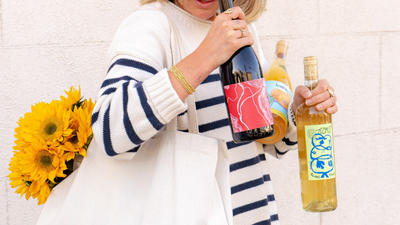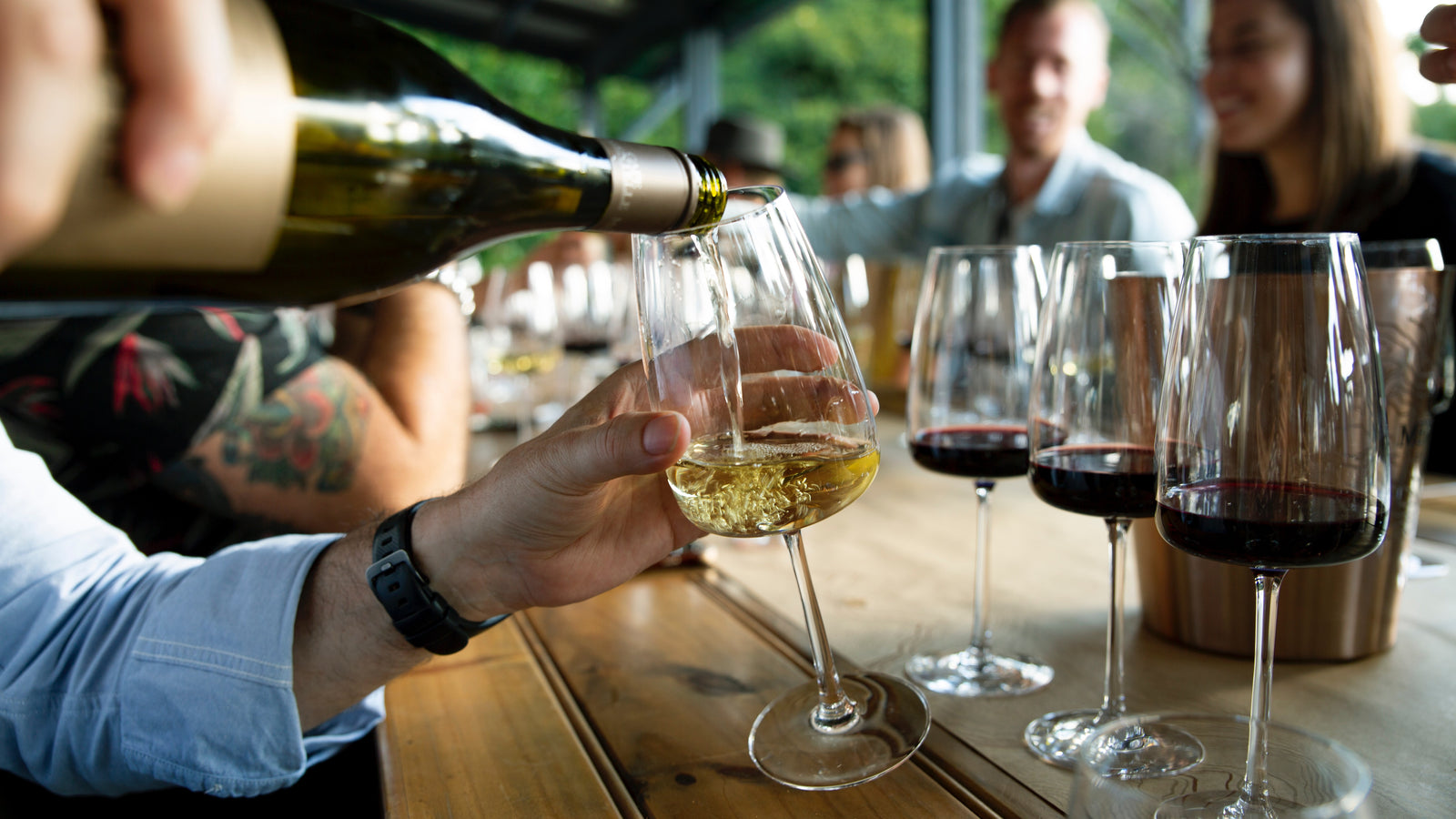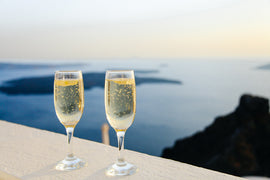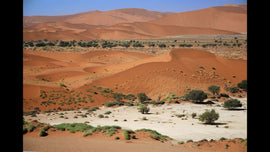Can you remember the last time you tasted an unfamiliar wine for the first time? (Last month’s club wines perhaps?) If the bottle is not in front of me, I search for clues to figure out what it is I am about to put in my mouth. I begin by admiring color, clarity, viscosity, aroma, and finally taste. Similar to tasting wine blind, I have only my organoleptic sensors to rely on — no scores, no write-ups. To my delight, wine has a way of drawing me in. And I’m not alone. In my restaurant days, I would offer customers tastes of wine without telling them what it was. They would admire the glass, spending minutes (or what seemed like hours!) smelling and swirling before the liquid ever touched their lips. (Yes, I am a guilty of such behavior, but swear I don’t do it with other beverages.) And what fun when the mystery was revealed. Our wines this month may be unfamiliar, but they showcase their distinct sense of individuality, and most importantly, from a drinking point of view, they are delicious!
Valle d’Aosta (Vallée d'Aoste to the region's many French speakers) is Italy's smallest region, just one-eighth the size of neighboring Piedmont. Comprising one large glacial valley running east–west and formed by the Dora Baltea River as it courses through the mountains, the semi-autonomous Valle d'Aosta contains some of Europe's highest peaks, including Mont Blanc (4810m), the Matterhorn (Monte Cervino; 4478m), Monte Rosa (4633m), and Gran Paradiso (4061m). The vineyards, planted for the most part on hillsides on either side of the Dora Baltea before the land rises to impossible altitudes, are frequently terraced into dizzyingly steep slopes. At one point the Valle d'Aosta had so many grape varieties growing you could write a book about it. Unfortunately, phylloxera (the aphid-like pest) killed most of the vines on local farms in the 1860’s, wiping out the majority of the region’s wine heritage. According to the local enology school, the Institut Agricole Règional, there are 13 grapes which have been identified as indigenous to the region. The other grapes grown reflect the influence felt from their French and Swiss neighbors. Native regional and other Italian varieties include Nebbiolo, Dolcetto, Petit Rouge, Fumin, Vien de Nus, Prëmetta, Moscato di Chambave, and Prié or Blanc de Morgex. French varieties include Pinot Noir, Gamay, Syrah, Grenache, Pinot Gris or Malvoisie, Pinot Blanc, and Chardonnay. There is also the Petite Arvine of Switzerland and the Müller-Thurgau of Germany. Torrette and Blanc de Morgex account for one third of the region's DOC production.
It is the geography that shapes the wines from this region, and more than anything else, altitude determines which grapes are grown in which locations. Red grapes are grown at lower elevations (around 300 meters), and at the upper levels (1200 meters) more whites are planted. The valley received its first DOC wine designation as far back as 1971 for a wine known as Donnas which is made from Pecotendro, a local version of Nebbiolo. One year later, a second DOC was created for another red wine, Enfer d’Arvier, made from Petite Rouge grapes. Since that time a few more DOC’s have been created, but most of the wine comes from the more encompassing Valle D’Aosta DOC.
Cave des Onze Communes is a cooperative in Valle d’Aosta in the heart of the French-Italian Alps that began production with the 1990 harvest. In an area where sheepherding, glaciers, and wine agriculturally mix, nobody’s got a huge amount of land. And because they are so small, operating individual wineries is not cost-effective. So relatively recently, a small group banded together to make their own wine. The Coop’s vineyards spread over eleven (onze) local municipalities (communes): Quart, Saint-Christophe, Aosta, Sarre, Saint-Pierre, Villeneuve, Introd, Aymavilles, Jovençan, Gressan and Charvensod). With over 57 hectares of vineyards worked by 220 owner-members, the cooperative produces over 350,000 bottles a year. The vineyards themselves are magnificent – they run up 1200 meters straight into the glaciers on vines that are trellised on the extremely old “tree” high-tier system. This allows cool air to sweep down the granite mountain and under the grapes and vines. Each vine gets its own tier, and each tier is hand-made to that vine.
Petite Arvine is a white grape variety grown mainly in Valais, Switzerland and Italy's Valle d’Aosta. It is unclear exactly where the variety originated, and growers and officials from both regions claim it as their own. Petite Arvine needs sunny sites that are protected from the wind so its grapes can reach full ripeness. The grapes for Cave des Onze Communes’ Petite Arvine come from organically farmed vineyards located in the Municipality of Saint-Christophe, on the left of the Dora Baltea, and to the right of Aymavilles, (basically as an extension of the Parco Nazionale Gran Paradiso). The vineyards lie at an altitude from 600 meters (1969 ft.) to 750 meters (2461 ft.), and the loose soils are composed mostly of lime and clay. After the grapes are hand harvested, fermentation takes place in stainless-steel tanks at cool temperatures to ensure freshness. The wine rests on its lees for a short period before being bottled.
The pure, clean character of Cave des Onze Communes’ Petite Arvine makes it a perfect “food wine”, particularly with delicate seafood preparations and fresh vegetables such as bok choy, green peas, spinach, etc. Try it with spicy Asian fish dishes, roasted pork loin, braised chicken, or hard cheeses. Traditional regional fare such as melted raclette cheese with cornichons, smoked ham terrine, or pan-fried white fish with lemon and capers pair deliciously.
The 2018 Cave des Onze Communes Petite Arvine is $24.00/bottle, $259.20/case
The wines from Onward are single-vineyard, site-driven wines created by Faith Armstrong-Foster. Born on a tiny island in British Columbia, Canada, and after working in marketing and sales in the boating industry in Canada, Faith discovered her interest in wine making by taking a position in wine promotion, marketing, and sales in California. The more she learned about wine, the more her interest grew. Her leap into production came from spending a day helping out at a winery. After shoveling grapes into her first fermenter she was hooked. What followed was a full Regents Scholarship to the University of California at Davis, and a Degree in Viticulture and Enology (with highest honors) in 2006. After graduation, Faith began working for Frank Family Vineyards, where she was soon promoted to assistant winemaker. Purchasing her first grapes in 2009 from a Mendocino grower whose practices she admired, Faith launched her own brand. Seeking a name for her wine provided the opportunity to pay homage to her unique childhood by choosing the name of the little boat in which she went to school every day. The name “Onward” equally references her natural approach to winemaking, honoring the history and authenticity of the grape and the vineyard site.
Faith’s wine making style is about letting the vines speak. She writes, “They are the art, I am the canvas, my job is to give them a chance to share their beauty in each and every vintage. My decisions are driven from the vineyard and the vintage, my cellar practices are to uphold the truths I find in the vineyard. To this end I pick early looking for balance of flavors at lower ripeness, as I find this is when each vineyard is in its most unique expression of self.” Faith’s wines showcase terroir in its purist form. There is quality, uniqueness, and a sense of place in every glass. Faith has a strong commitment to our environment and believes that sound practices are not only essential for the survival of the wine industry, but also produce the highest quality wines.
Onward’s 2016 Carignan is made from grapes that are grown on the Casa Roja Vineyard. Dan Gonsalves and his family have been growing grapes in the Oakley area of Contra Costa County for over 100 years. The Casa Roja Vineyard is an historic field-blended block that is one of the oldest vineyards in the area. The vineyard sits at 20 feet elevation, just inland from the San Francisco and Suisun Bays at the entrance to the Sacramento Delta. It was planted in the late 1800’s, and while it is over 90% Carignane, it also has some Mourvèdre and Malvasia Nero interplanted in the block. The vineyard sits on 100% sandy soils, giving rise to smaller, hardy bush vines trained so the fruit is shaded from the wind and sun. The result is an intensity of flavors that opens to black fruits with a soft lushness due to the maturity of the vines and the uniqueness of the site The maritime influence is remarkable, giving rise to a 60-degree diurnal shift that allows for early ripening while maintaining vibrancy.
For the 2016 Carignane, Faith placed a layer of whole clusters at the bottom of the fermenter, then the remaining fruit was de-stemmed and the whole berries transferred to the open-top fermentation tanks to cold soak prior to fermentation, which allows for delicate extraction and adds complexity. Gentle extraction was ensured also by performing punchdowns to mix the must, while higher temperatures were encouraged to soften tannins. Only natural yeasts were used during fermentation. After fermentation, the wine was pressed and sent to neutral French oak barrels, where native malolactic fermentation was encouraged.
Spice notes with rich blackberry aromas jump out of the glass when you pour the 2016 Onward Carignane. The palate reveals flavors of juicy plums, boysenberries, zesty hibiscus and fresh cranberry over a layer of black berry cobbler. The rich blue and black fruits are tempered by brilliant acidity that keeps you wanting more. This wine will pair deliciously with roasted and cured meats, roasted squashes, eggplant lasagna, or a savory onion and mushroom tart. The wine can pair particularly well with the spices of southern Spain and even the piquant seasonings of Morocco and Algeria.
Onward’s 2016 Carignan is $28.00/bottle, $302.40/case





